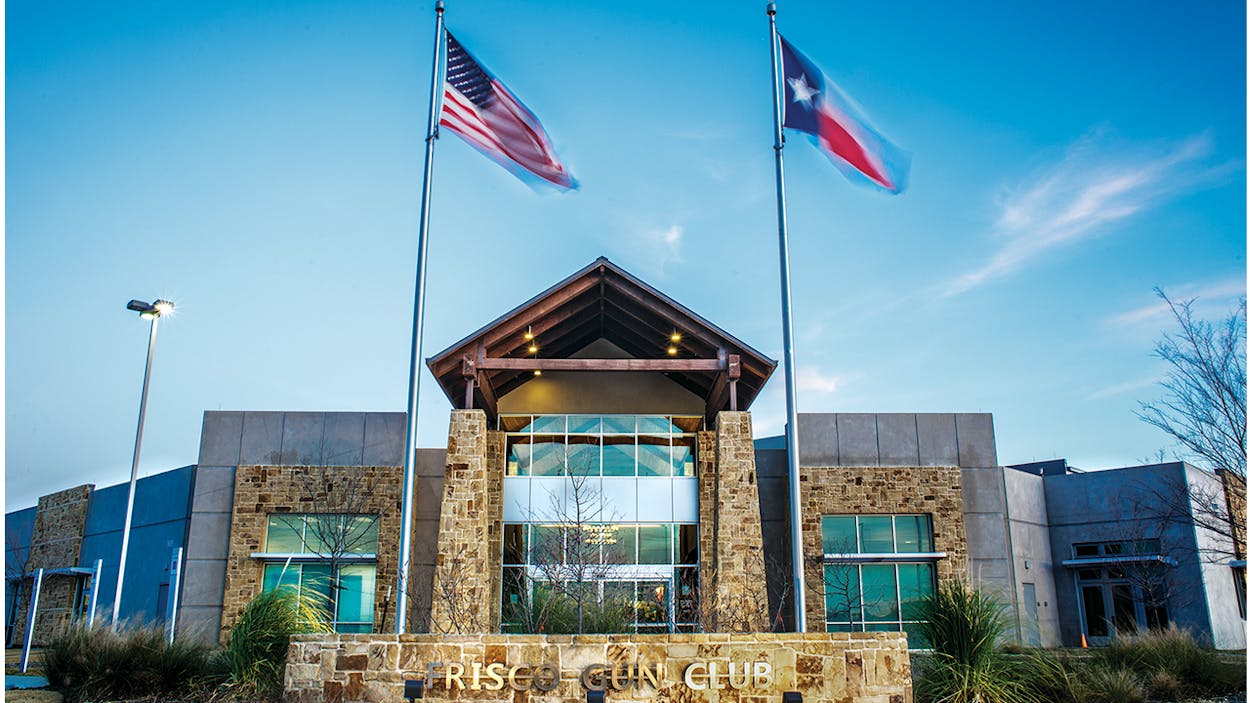What does a high-net-worth individual want when he visits a gun range? He wants a VIP lounge where he can get a steak and a bottle of wine after he shoots. He wants members-only lanes where he can shoot at any time of day or night. He wants a concierge to get him another box of 9 mm ammo before he knows he’s out, like a good caddie at a country club. He may not have known it until the place appeared in this Collin County suburb right around Thanksgiving 2013, like a warm and tactful “You’re welcome” from God, but he wants the Frisco Gun Club.
Most indoor gun ranges begin life as warehouses or industrial facilities, and functionality tends to be the watchword. The Frisco Gun Club is a $12 million enterprise built from the ground up. It features 36 pistol lanes; 4 rifle lanes; a large sales floor for guns, apparel, and related merchandise; a coffee shop; and a gourmet restaurant. It is one of a handful of upscale gun ranges—known as guntry clubs—that have opened around the country in the past ten years or so, though it is the only one that offers fine dining for those who can afford the highest level of membership.
All money in Frisco is new money. Just 25 years ago, this bedroom community north of Dallas was a dusty town of 6,000, with cattle grazing less than a mile from Main Street. Today the population is close to 150,000, and its carefully gridded neighborhoods, spread along either side of the Dallas North Tollway, boast good schools, nice parks, and row after gently curving row of large houses on lots that seem just a tad small for the hulking domiciles they host. Not every person in Frisco is well-off, but it is the wealthiest city of its size in Texas, followed closely by fellow Collin County suburbs McKinney, Allen, and Plano.
Frisco’s new favorite place to shoot had a decent-sized lunchtime crowd on the crisp January day I visited. Customers strode purposefully through the tastefully landscaped parking lot, pistol cases at their sides like curiously shaped gym bags. The sandstone-and-brushed-steel facade suggested a fitness club too—or maybe a recently opened bank branch—though the muffled pop-pop-pop coming from the lanes within became impossible to miss as I approached the glass double doors. Inside I met Brandon Johnson, the club’s 44-year-old vice president of marketing, who gave me a tour. The entry has a vaulted ceiling with a clerestory and plenty of shiny black marble, sandstone, and cherrywood trim. Beyond is the sales floor, where customers can peruse dozens of pistols and rifles, including a selection of vintage English shotguns priced as high as $40,000. There was not a trace of country kitsch; the club’s decor is meant to evoke Barneys or Neiman Marcus, Johnson told me, not Cabela’s. Johnson himself wore a black sweater vest monogrammed with the club’s logo in flowing gold script over a purple button-up; his stylish glasses looked as though they might have actually come from Neiman’s. Like most of the club’s employees, he was licensed to carry, and somewhere under that vest, he told me cheerfully, was a pistol. I think it was in the small of his back, but it was hard to tell.
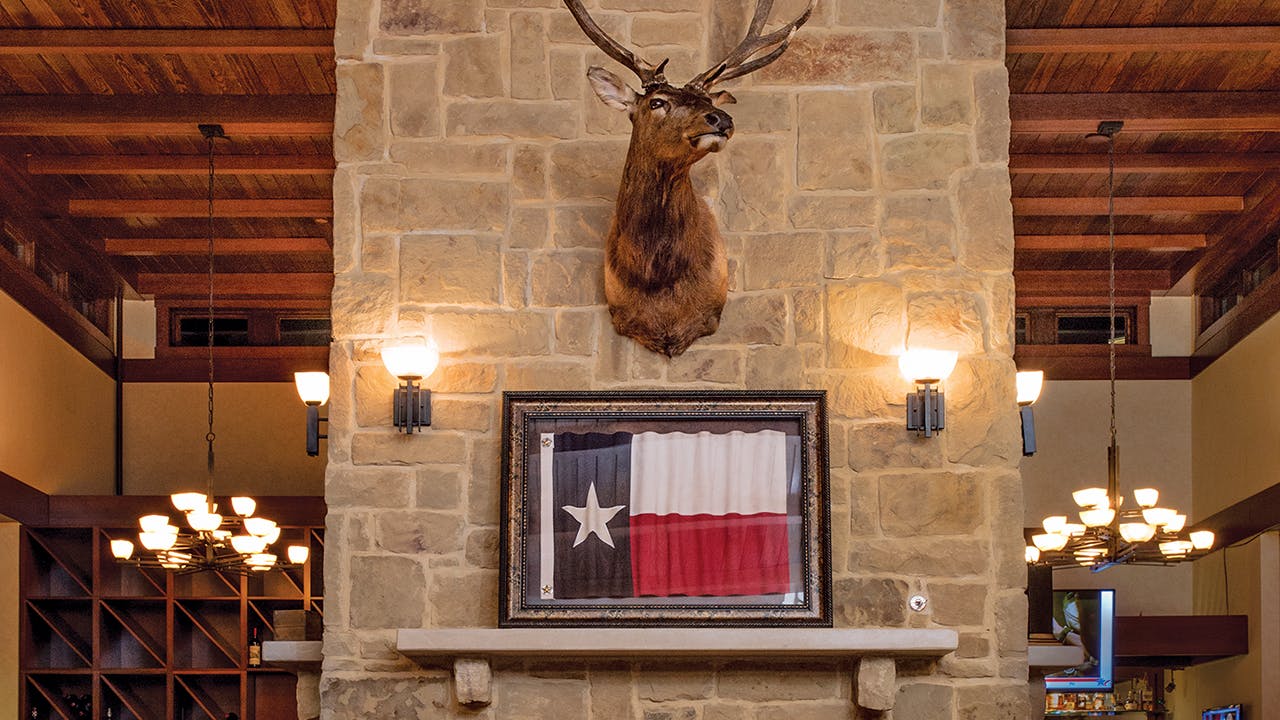
You don’t have to be a member to shoot at the club, but for $7,500, plus a $200-per-month fee, you get full access to the restaurant and bar. Six private shooting lanes are also reserved for VIP members. Johnson steered me to the dining room, which was modeled after a luxury hunting lodge, with an open-hearth fireplace in the center, high-backed chairs, and plenty of big-game trophies on the walls, some of which—like the elk and black bear mounts—had traveled quite some distance to add to the room’s ambience. The place was mostly empty, though there were a couple of business lunches under way. It was not hard to imagine a professional bringing in a client to close a deal, as one might at a traditional country club, despite the somewhat distracting thump, thump, thump coming from the shooting lanes behind the room’s rear wall.
Johnson showed me into an adjoining cigar lounge and introduced me to one of the club’s regulars, a retired executive named Jim Fox, who used to own a company that sold coin-and-currency-counting equipment. He was wearing a green sleeveless sweater and holding a freshly poured craft beer. Fox had just finished shooting in one of the private lanes, and his face was slightly flushed. He began bringing prospective clients into the club shortly after it opened, he told me. “A lot of them have never shot before,” he said. “They go crazy for it.” Unlike golf, he pointed out, shooting could be enjoyed in any weather, and it didn’t take all afternoon. “You shoot for an hour; you have a nice meal,” he said. Fox himself hadn’t been much of a shooter before he joined, but now he is a hand-loader, which is to say he assembles his own bullets, the mark of the true aficionado. His wife is a regular too, though she doesn’t shoot. She just enjoys spending time in the club. “Women like it here,” he said. “It isn’t Bubba’s gun range.”
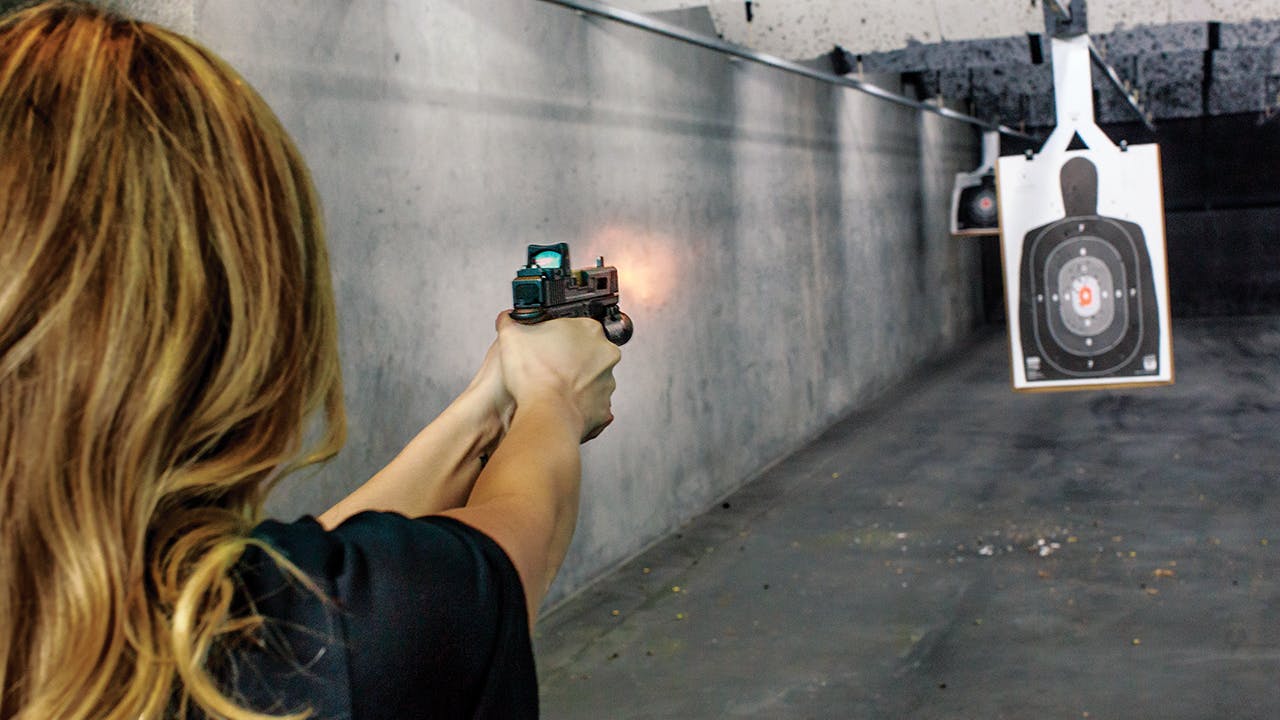
Over lunch, the club’s general manager, Ken Love, explained why the range appeals to the VIP members. “A lot of these guys have a big collection. It’s one of their favorite things to do. It’s ‘I’ve shot this gun for a few months now. It’s time for something new.’ ” A wealthy member invited Love to dinner at his home one night and showed him his collection, which included around 350 guns. “He doesn’t have a gun safe. He’s got a safe room that you could probably put forty people in,” he said. The club is a place to talk guns with other people who enjoy them, Love said. “They get to bring their status symbols with them and show them off to all their buddies.” Several Dallas Cowboys have joined, including running back Darren McFadden, who came in and bought Smith & Wesson 500s—truly enormous revolvers—for his offensive linemen, at $1,200 apiece.
As with any other club, there are special events. Last Easter, members were invited to shoot at plastic eggs on the range; whoever hit the one with the gold confetti inside got a free brunch. The club’s first wedding reception is in the offing.
The real secret to the business’s success, Love told me, wasn’t the VIP privileges, as popular as they have been. It was the club’s appeal to the uninitiated shooter. “It’s just like going bowling,” he said. “You show up and you don’t need to have anything. We can get you a gun, eye protection, ear protection, ammunition, whatever you need.” The gun business is not the male-dominated, macho scene it was twenty years ago, Love said. “I’ve seen more families—mom, dad, and the kids—come into the gun range for entertainment. It’s just become more mainstream.” There are plans to introduce a Friday Date Night package, as an affordable alternative to dinner and a movie. The club has also proved a popular spot for corporate team-building events. The Frisco Gun Club and its ilk around the country are doing for shooting ranges what the Top Golf chain has done so successfully for driving ranges, making an “experience”—complete with dinner, drinks, and camaraderie—out of what used to be a fairly mundane activity.
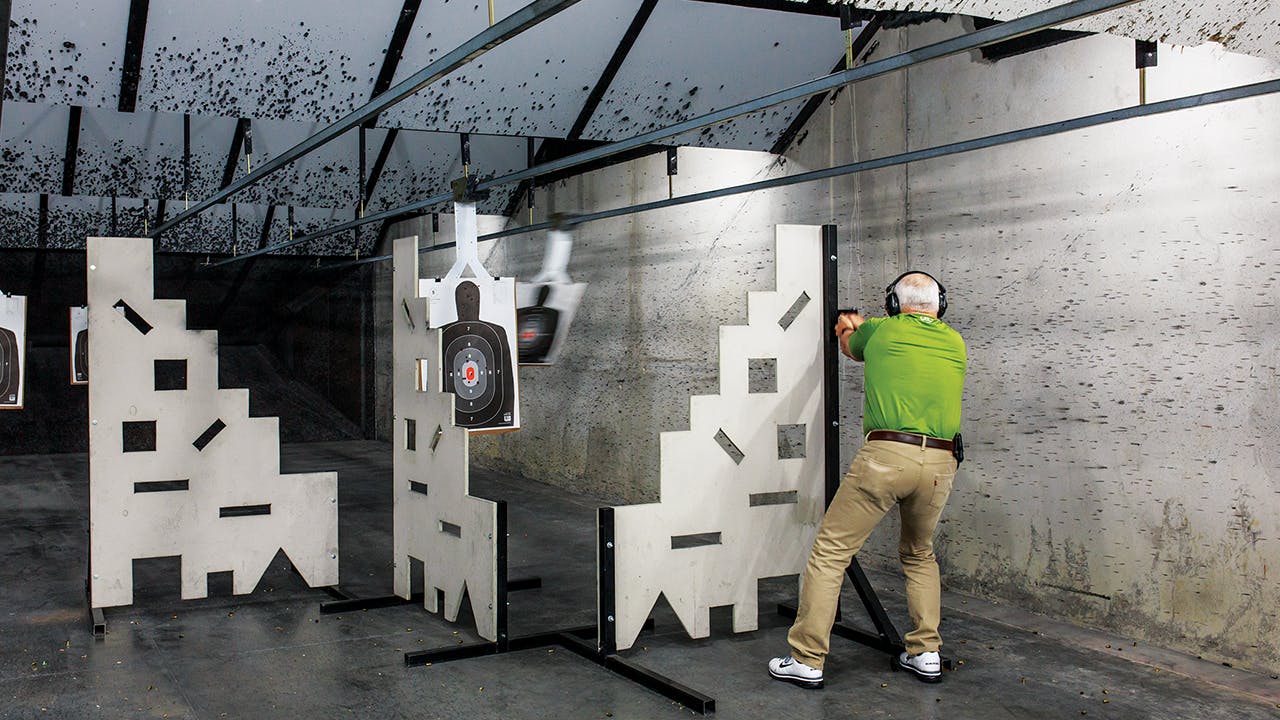
I came back that evening to get a sense of how entertaining guns can be. It was Tactical Tuesday, which meant that some of the club’s more seasoned shooters would get a chance to try something besides standing behind a counter, plugging away at targets. In the world of amateur gun owners, the term “tactical” is a catchall reference for anything that supports the illusion that one is not an amateur gun owner but instead a cop or a soldier. There are tactical outfits, tactical footwear, tactical holsters, tactical modifications for your gun. Your flashlight can be tactical, and so can your backpack, as well as your rations, if you get into the whole survivalist scene, in which case you will learn that almost everything has a tactical alternative, even toilet paper. On Tuesdays, customers can bring their pistols and spend an hour moving through a kind of obstacle course set up on a reserved section of lanes, shooting at paper targets stationed here and there throughout the course to represent bad guys, if bad guys didn’t move or shoot back.
On this particular evening there were four participants, all middle-aged white men in jeans and tennis shoes. The instructor was in his late twenties, trim, with a short beard and orange-tinted protective glasses that definitely fell into the tactical category. The shooters warmed up for a while with their pistols, taking turns drawing from holsters on their belts and shooting from behind a white-plywood-and-steel screen at a nearby target. When it was time to reload, they helped themselves from a cookie tin filled with shiny shells, heaped high like dinner mints. Periodically one of them took a push broom and swept all the spent brass casings out from under foot. They tinkled like money.
Despite what Love had told me at lunch, standing on the range itself did not feel like being at a bowling alley. It was more like visiting the shop floor of a factory, one where big machines stamp and punch and bang while people mostly just stay out of their way. It was unpleasantly loud, earmuffs and all. Even when nobody was firing, the range’s aggressive ventilation system, which pulled the gunpowder-and-lead-laden air away from the shooting bays, thumped and whirred ominously. A strong odor of sulfur permeated the place, along with an unmistakable metallic tang that accumulated in my mouth as the minutes went by.
After I watched the students stalk through the Tactical Tuesday course a few times, it wasn’t hard to see why most ranges don’t let customers draw from their holsters while shooting. You have to tug the pistol out quickly without letting your index finger grab the trigger, which is where the design of the grip would have it land. Three of the students had it down pat, but the fourth was a chipper, short-waisted little fellow whose abilities didn’t seem to match his expensive gear, and I found myself cringing every time he scrabbled at his belt for his pistol. It would be so easy to shoot yourself in the thigh or, for that matter, to bounce a bullet off the steel obstacles in the training course and back into the people watching behind you. I admit to scratching out the word “Tactical” next to “Tuesday” in my notebook and inserting “Tortious” in its place.
Halfway through the session, a small group—raffle winners from a technology trade show set up in the club’s classroom—entered the adjoining section of lanes, and I watched through the window of a steel door while they took turns firing an AR-15 machine gun on full auto. A club employee placed a hand between the shoulder blades of each shooter to help brace against the gun’s recoil, as the others stood behind in a semicircle laughing nervously at the gun’s deafening boom. It was hard to say whether they were bonding; visiting with the person next to you is difficult through the heavy plastic earmuffs required on the range. But they were undoubtedly having an experience.
I asked one of the shooters in my section, a burly, balding 37-year-old named Justin Taylor, what he liked about the class. “I was one of those guys that always went to the gun range and just shot,” he said. “You think you’re really good and you think if you get into a bad situation you’d be able to handle it.” But when he took the club’s class on how to survive active-shooter situations, he said, he realized he wasn’t prepared. That’s where Tactical Tuesday came in. “It’s more like real life,” he said.
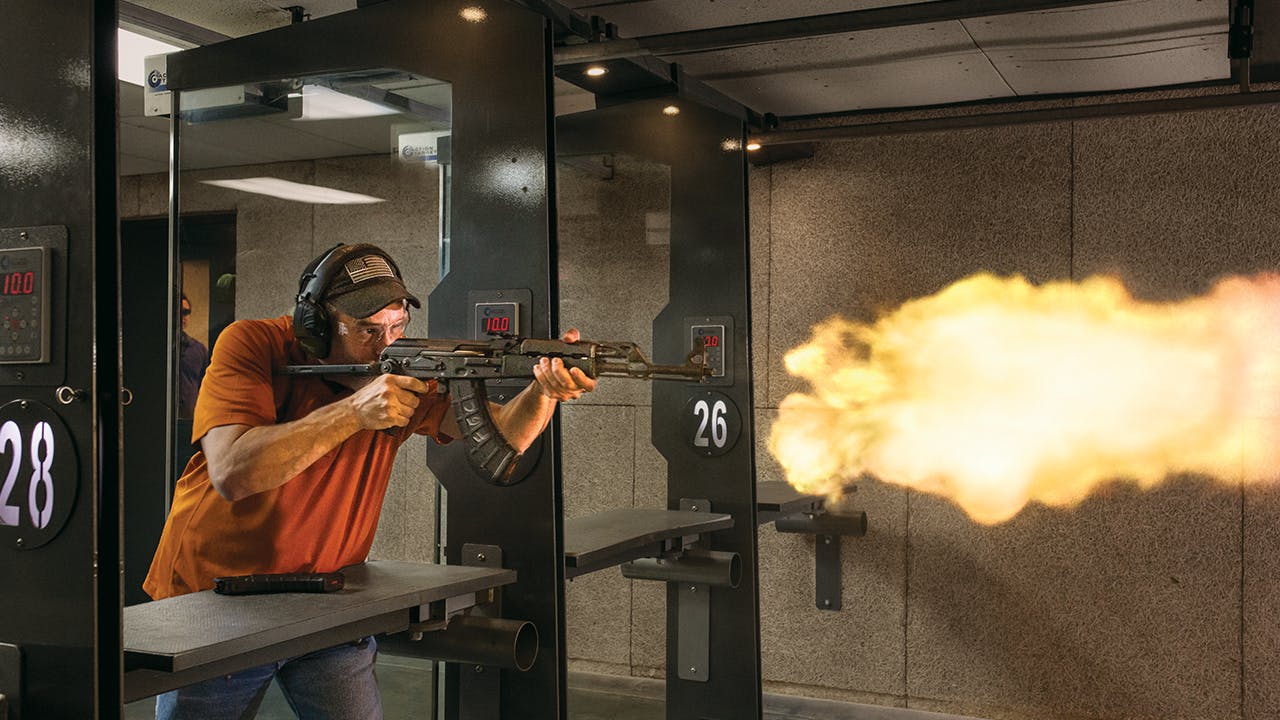
If we are getting real, we are probably not coming to the Frisco Gun Club at all, at least not for self-defense-training purposes. There were 31,181 robberies in the state of Texas in 2014. Only 20 of them happened in Frisco. People do sometimes get murdered here, but if recent history is any guide, you have more to fear in Frisco from the people you know best than you do from anybody invading your home, sneaking up on you in a dark parking lot, or rampaging through your office. In May 2015 a man was indicted for allegedly shooting his ex-wife in her garage, one of two killings last year. The other occurred during an attempted robbery of a drug dealer at an apartment complex. In the summer of 2014, a sixteen-year-old killed his parents with a rifle. That same year, a woman being investigated in the death of her ten-year-old son bludgeoned her husband to death and then killed herself with sleeping pills. Nobody got killed in 2013 or 2012, but 2011 saw three murders: of a cash-for-gold-store owner by an unknown person, a toddler by his adoptive father, and, finally, a party to a drug deal that went bad in a Walmart parking lot. If the goal is making sure you are not among the zero to four people murdered in an average year in Frisco, a more useful class might teach you how to tell if your close relative, disgruntled ex, or prospective illegal-drug client is planning to kill you.
Statistically speaking, you are very unlikely to be a victim of violent crime in any wealthy suburb. If you are in the gun business, however, the suburbs are where the action is. The more wealthy and white a community is, the more likely its residents are to own guns, which helps explain why Frisco is such a great place to sell firearms. It is also, according to the Frisco Gun Club’s owner, an entrepreneur named Christian Putnam, one of the few places in the nation where a business like his could be a viable concern. “You have to have a concentration of high-net-worth individuals and there has to be an interest in guns,” he said in an interview in his spacious office at the club. When Putnam was scouting locations for his new venture, a national gun industry association shared some polling data and some advice: build in Frisco.
Putnam, who is 49, wore hip sneakers, jeans, and one of the club’s blue polo-style monogrammed shirts. He made his money founding an information technology start-up in Dallas in the nineties and hit it big when Walmart and other large retailers adopted his software. He is tall and slightly stocky and has the kind of informal air you associate with someone who works at a software start-up. He admitted to being something of a Johnny-come-lately to the gun business; his first foray was the purchase of a family-owned gun range in Plano in 2009. “I was shocked at how good a business it was,” he said.
Putnam is nothing if not savvy. He built a hundred-person classroom at his new range, mostly to take advantage of the tremendous demand for concealed carry licenses. This permit—known these days as a “license to carry,” since its holder can now legally wear a gun on his hip as well as in his pocket—has become a cash cow for gun sellers. Customers come in to gun ranges to take the mandated safety classes, for which they pay a fee, and then shop for guns at those same ranges. Putnam estimated his club is the biggest provider of training for such permits in the Metroplex “by a factor of three or four,” which in turn has helped him become one of the biggest gun dealers in the area.
The problem with the gun business in general, as Putnam sees it, is that it’s dominated by former cops or military veterans whose passion for guns eclipses their business sense. “I bleed just as red as any of them on Second Amendment rights,” he said. “But I think from a business point of view it’s smarter to let other people fight that fight for you.” Still, nobody in this business can afford to ignore politics. Just as Putnam was about to break ground on the Frisco Gun Club in 2012, twenty children and six adults were massacred at Sandy Hook Elementary, in Newtown, Connecticut. He pushed back his ground-breaking celebration a few weeks “out of respect” for what happened, he said. But Sandy Hook didn’t hurt him—far from it. Sales at his existing gun range in Plano went through the roof. “One of the things I dislike about this business is that we benefit from tragedies, mostly because of the gun-control debate that goes on,” he said. “People want to buy what’s going to be taken away from them.”
The gun business tanked in 2014, as it inevitably does after a boom, but now sales are leveling off, and the prospects are good. “We have an election year,” Putnam pointed out. Gun sellers still marvel at the massive surge in sales when Obama was elected in 2008, prompting widespread fear that a federal crackdown on gun ownership was imminent. It was not. Now there is the prospect of a Hillary or a Bernie bump. And the broader political situation is favorable too. “I think there’s some concerns about ISIS and terrorism after San Bernardino,” he added. “People want to make sure they’re armed.” Putnam told me that the majority of his customers buy guns for home defense. I mentioned Frisco’s low crime rate, but he said there really was no correlation between gun sales and crime. “It’s counterintuitive,” he happily agreed.
In fact, Putnam does not want you thinking about crime at all while you are at the range; he wants you to have a good time. The entire notion of a country club where members spend their afternoons shooting pistols instead of playing golf would be untenable if shooting weren’t fun, which is to say if guns, like golf clubs, did not make good toys. Firearms are undeniably playthings at the Frisco Gun Club, and I saw quite a few people having a good time. And yet the club’s message about guns can be a little confounding. I found myself thinking of a framed Andy Warhol print I had noticed earlier in the day on the wall of the private cigar lounge. It was a painting of a black revolver—along with its ghostly white double—on a stark red background. You can see why someone thought it was a good idea to hang it there. Thematically, the image is a logical choice, and the Warhol brand—sophisticated, urbane—reinforces the club’s own branding efforts in general. You do not see Andy Warhol prints in the dressing room at Cabela’s.
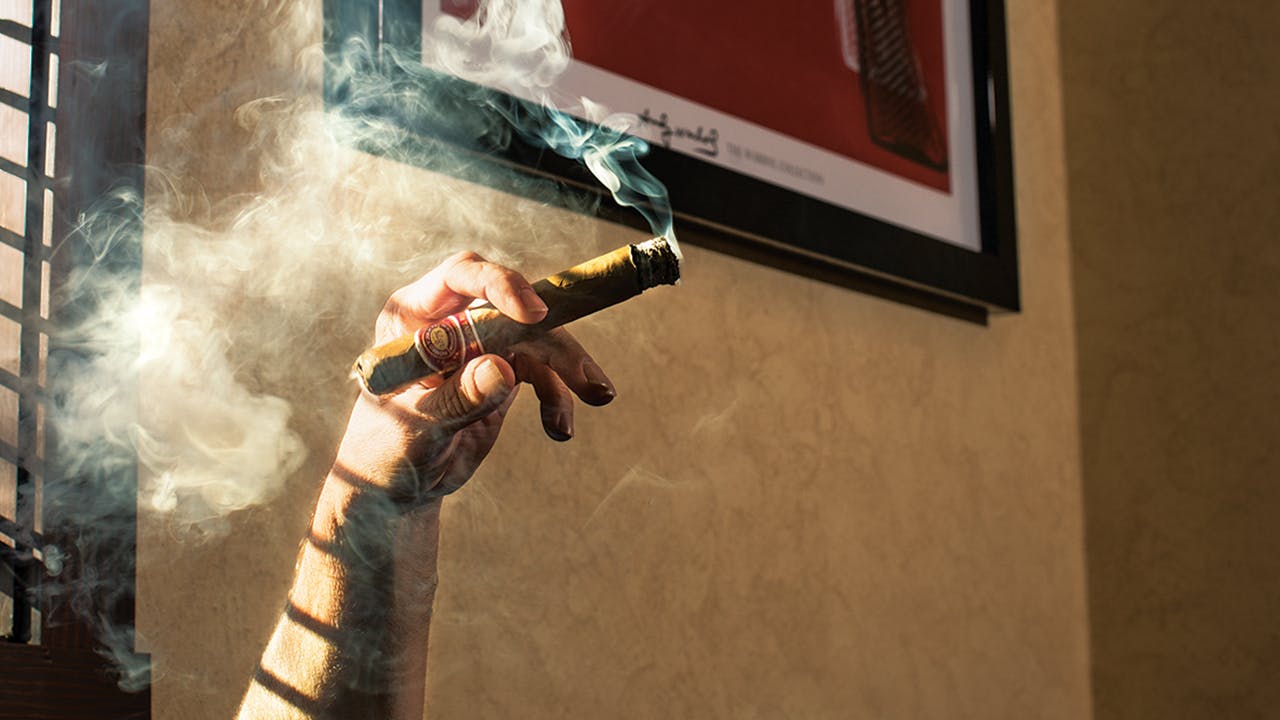
For Warhol himself, however, the image was disturbing. A demented writer and radical feminist named Valerie Solanas carried a similar model—along with a .32 automatic—when she tried to kill Warhol at the Factory, in New York City, in 1968. He barely survived the attack, which damaged his lungs, liver, spleen, stomach, and esophagus and kept him in the hospital for two months. He never stopped thinking about those guns; the print was part of a series he created in the early eighties, when he was still struggling both physically and psychologically with the aftereffects of the assassination attempt. The painting was a morbid reflection on the most horrible thing that ever happened to him.
If you don’t know the context in which it was created, however, it’s a cool picture of a cool gun. Your ability to enjoy yourself at the Frisco Gun Club might depend, as much as your appreciation for the perks of membership and the finer things in life, on the degree to which you share this singularly American tendency to separate symbols from their meaning. The main thing the club’s proprietors would like you to forget is this: just as hitting golf balls at a driving range is practice for playing golf, shooting targets at a gun range is practice for shooting people. You might think this would be a difficult fact to ignore, since pistols were invented for the sole purpose of killing humans, and the preferred target at the Frisco Gun Club, as at most gun ranges, is a silhouette of a man’s head and upper body. And yet when a shooter spends half an hour pumping bullets into a man-shaped target at ten yards, he does not think to himself, “I have just killed a person,” over and over again with each shot. When he leaves the range and retires to the VIP lounge, he is not thinking about a shooting victim, like Andy Warhol, lying in a heap on the ground. Who could enjoy a cigar under those circumstances?
Putnam’s success has spurred imitators: a high-end range will open soon in Fort Worth, and others are slated for construction in North Richland Hills and Austin. Putnam hopes his creation is unconventional enough to move beyond the inevitable boom-and-bust cycles of the gun business. “People think of these businesses as either gun ranges or gun sellers, but Frisco Gun Club is really a different model,” he said. “It’s more like a gym.” Or a country club, though Putnam said he wasn’t too sure about the future of that institution. “Young people aren’t playing golf,” he pointed out. They are shooting, however: the number of children coming to the club has been growing exponentially, he told me. “It’s just a fun, safe thing to do, you know, shooting a gun,” Putnam said. “It’s a lot of fun.”


